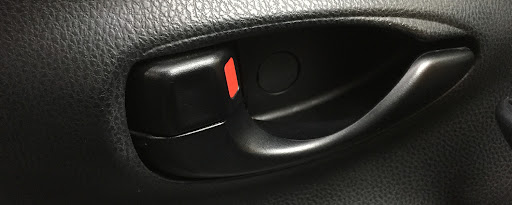Time to read: 9 min
The camera is one of those things that is not only a long-standing historical item (the first one was invented in 1021 AD, if you want to get really technical) but also one that continues to attract innumerable entrepreneurial efforts. You’d think every variation on the camera that could possibly be invented already exists.
But, apparently not: the three-man team at Podo has come up with yet another take on this ubiquitous device. But this time, you don’t hold the camera in your hand. You stick it somewhere—a wall, a signpost, your friend’s forehead. And you free millions of strangers from having to take your and your friends’ pictures for you.
To explore how you create something truly new in a crowded market and live to tell about it, we talk to Podo co-founder Eddie Lee.

Growing an idea to business reality
The three co-founders of Podo (Eddie, Sam Pullman and Jae Choi) didn’t start out with a camera product. They had already been trying to start a different business—an app for mobile ads. But when they brought it to an incubator, the investor they spoke to liked them more than the idea.
“He told us we have to change our idea because [the app] would be hard to scale,” says Eddie. “During one of our brainstorming sessions, I wanted to take a surreptitious photo of us, a selfie really. Because group photos are usually structured and that disrupts the moment. But I couldn’t do it—my phone camera of course can’t take a picture of me and the others on the other side of the lens at the same time. So I had the idea for a stand-alone camera [for selfies].”
The idea to attach adhesive onto the camera case and make the Podo self-sustained sprouted from a physical problem—that of placement.
“So we had this idea for a cool connected camera, but we still needed somewhere to put it.” Eddie explains the whole point was for people not to have to hold it while taking pictures. “Suction cups or magnets would be too limiting, and I remembered the video of a sticky rubber pad on YouTube. It was just a matter of hunting that material down, testing it, and improving on it for our needs.”
The video Eddie’s referring to, if you’re curious, was of a young man using the sticky material to attach frying pans, among other objects, to walls. You really never know where the solution to your hardware products will come from.
“Our idea came from a problem, an actual need,” says Eddie. “And as it turns out, if you have a problem, it’s very likely that a lot of other people have that same problem.”
He adds, “We were at a time in our lives where we weren’t fully entrenched in careers, so we were able to take the risk. And when you’ve got three friends, it’s easier to say, hey, let’s do something together and learn through this life experience. Plus, we had these complementary skills that made us think it was feasible. So we said, why not?”
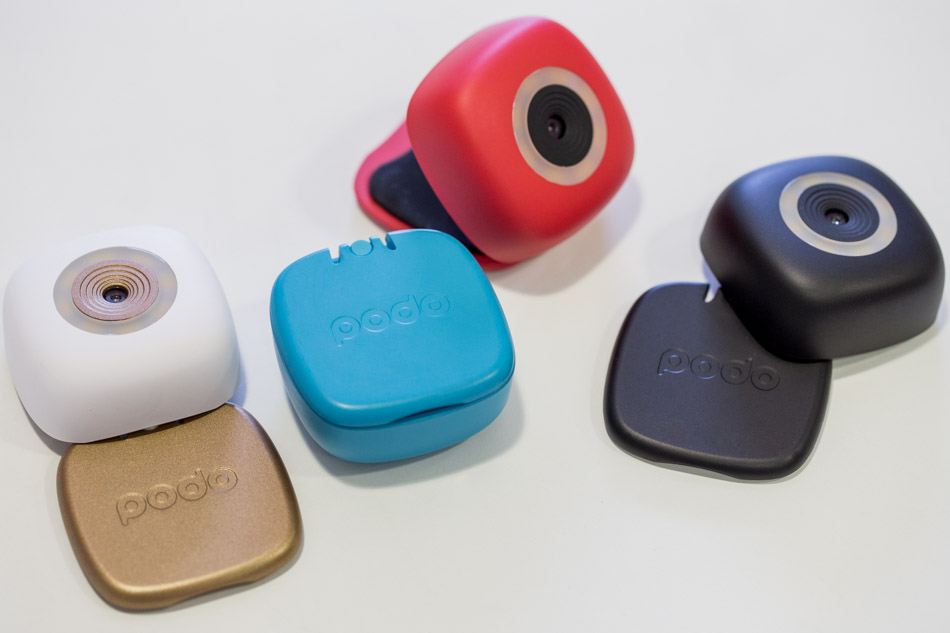
The differentiating factor
Sure, you want people to connect with your new product through their shared challenges, but on the other hand, you want to get as far away from the competition as possible. So, given that a camera has to have certain universal features and functions, how do you stand apart from the crowd?
“When we started,” explains Eddie, “Life logging was a hot trend. We knew our biggest competitor would be the smartphone, because of that convenience factor. The selfie was the best people could do for the amount of effort they were willing to expend.”
And yet, despite the obvious link, Eddie shares that “we didn’t want to call ourselves ‘the selfie camera,’ but it’s a good angle. Our branding is all about fun and appealing to a younger demographic. Podo is like a fun photo-taking buddy.”
But selfies only work with one person—or a very crowded group of three. “People take lots of group pictures,” says Eddie. “Friends, coworkers, and especially families. So that’s why we created Podo. If you’re going to do something new and it involves people, there might be a great photo-op, and you don’t want a stranger to ruin your shot.”
We’ve all been victims of the random tourist or passer-by to whom we’ve entrusted our special moments, only to have our images compromised by being out of focus, with way too much headroom, or just the wrong split-second captured.
“Exactly,” laughs Eddie. “It’s freedom and control at the same time. Control is a selfie; freedom is a tripod and a timer. It’s hard to get both.”
And that’s what the team focused on: making the selfie work for more than the one person, with a lot more convenience. All of the design and functionality choices the Podo team made for their new camera were about user friendliness.
Your peeps feeling too self-conscious in front of the camera? You can decide when to take the shot via your smartphone, instead of standing behind the camera and making everyone say “cheese” with those pasted-on smiles.
Tripods too heavy or awkward to carry around? Podo has a hinged flap that lets you angle it just right, and a sticky pad that makes it possible to attach it to virtually any surface—wood, plastic, metal, brick.
Too many buttons/icons to tap on your smartphone? Podo has no buttons. You tap the camera case anywhere, and it turns on.
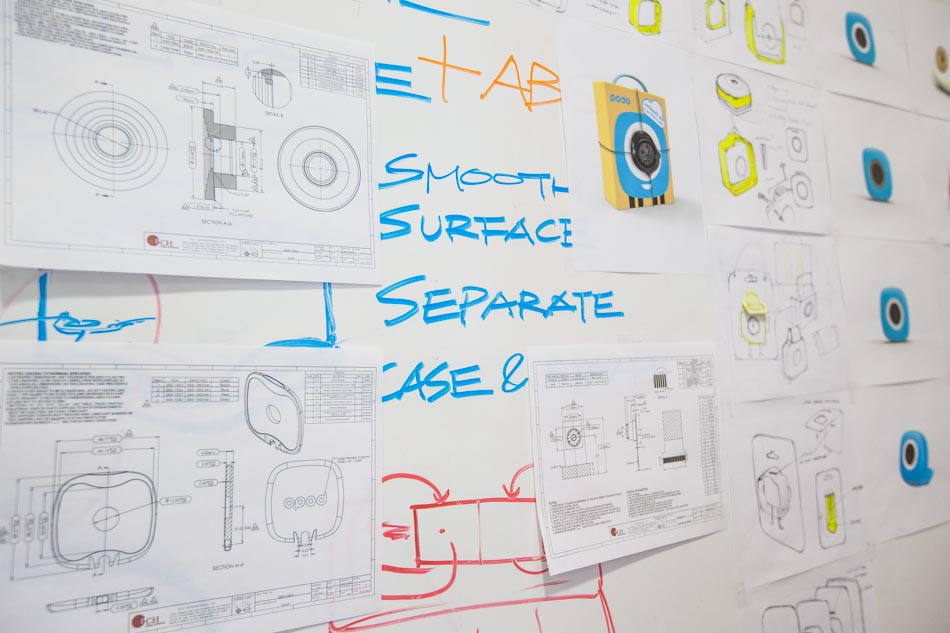
Making that ever-elusive UX seem effortless
“Fine-tuning that double-tap was a lot of work for our electrical engineer,” says Eddie, with a grin. “We programmed it to have a [certain] rhythm and strength to prevent accidental turn-ons.”
Podo tells you it’s active through its lights. It has a ring of eight small lights that animate when the device is searching for Bluetooth, and the top light stays on to indicate the “on” status. Even when you rotate the camera, whichever light bulb is at the “top” is the one that turns on. In other words, this camera has an accelerometer to detect impact and orientation—one less thing to worry about.
“We put [the accelerometer] in there from the get-go because it simply made sense,” explains Eddie. “We could have had an indicator that this is the top, but that’s an extra step. It’s all about reducing steps.”
As for turning it off, you need to do that through the companion phone app. Why not just another double-tap? Simple, says Eddie. To prevent confusion.
“The pain of accidentally turning it off is greater than accidentally turning it on,” he says. Imagine setting up the perfect shot with all your buddies, and then someone—or something—double-taps it accidentally, or “accidentally” (say, that cute kitten that used to be your YouTube star until you got Podo).
The team also spent a lot of time drilling down into what the appeal of a camera is in the first place. That has changed a lot since 1021 AD.
“We had all used the GoPros, the DSLRs, and in most of these cases, you still have to buy SD cards, and that’s a pain,” says Eddie. “It’s really not about the filters or the megapixels. It’s about what’s in the photo in the first place.”
Ah, yes, content and the user’s experience of that content. Nothing new under the sun, but still a critical focus that too many startups somehow ignore or forget.
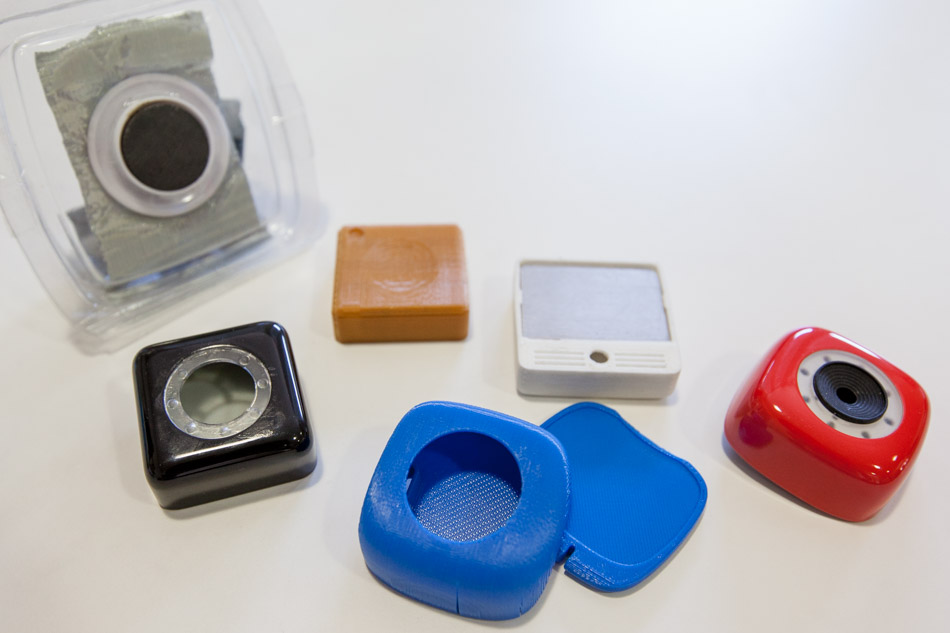
The joys and pains of Podo-typing
The first physical incarnation of Podo was an unwieldy mess, as Eddie tells it.
“We had a case concept that was 3D-printed, and we had this ginormous circuit board and we couldn’t fit it into the case. The batteries were attached to the camera with masking tape. It looked like a bomb. We thought we’d get kicked out of a TechCrunch networking event.”
On the positive side, Eddie says, they were able to get a viable image feed from the camera, but “…we couldn’t beta test with this first prototype. We couldn’t give someone that huge circuit board and say, ‘OK, pretend you’re sticking it on the wall!’”
There was another challenge—the sheer amount of time and cost involved.
“It took approximately a year and a half to put it all together,” shares Eddie. “In terms of the form factor, it was unacceptable to have a prototype that wasn’t 90% the real finished Podo. And we didn’t want to pass on any unnecessary costs to the consumer.”
The first camera designs were all square—a logical design choice for a camera. But then the team noticed that the name they had chosen for the company and product—“Podo,” which means grape in Korean—has numerous circles in it: two o’s, and the body of the “p” and the “d.”
“So we rounded the corners but didn’t want to make it a full sphere,” says Eddie. “That’d be too much like a security camera. All those concentric circles we have on the front face, yeah, those were a pain for Sam [Pullman, co-founder]. He had to make a ring of LEDs.”
As for materials, the case had to be plastic, both because of weight and cost. That’s true for a lot of consumer products these days, “smart” or not. But what Podo learned they needed to pay particular attention to was the hinge—the hinge linking the camera body with the flap that attaches it to surfaces and lets people angle the camera.
“You can’t have the same types of plastics rubbing against each other in a hinge,” explains Eddie, “because it will squeak and wear itself down. One material needs to be stronger than the other.”
The ball of the hinge is polycarbonate (PC) mixed with Teflon, the back flap is PC only, and the front cover is ABS plastic. The light ring itself is PC mixed with white pearly elements.
So far, Eddie tells us, negative feedback from users is related to buggy software, rather than the design or materials of the device itself.
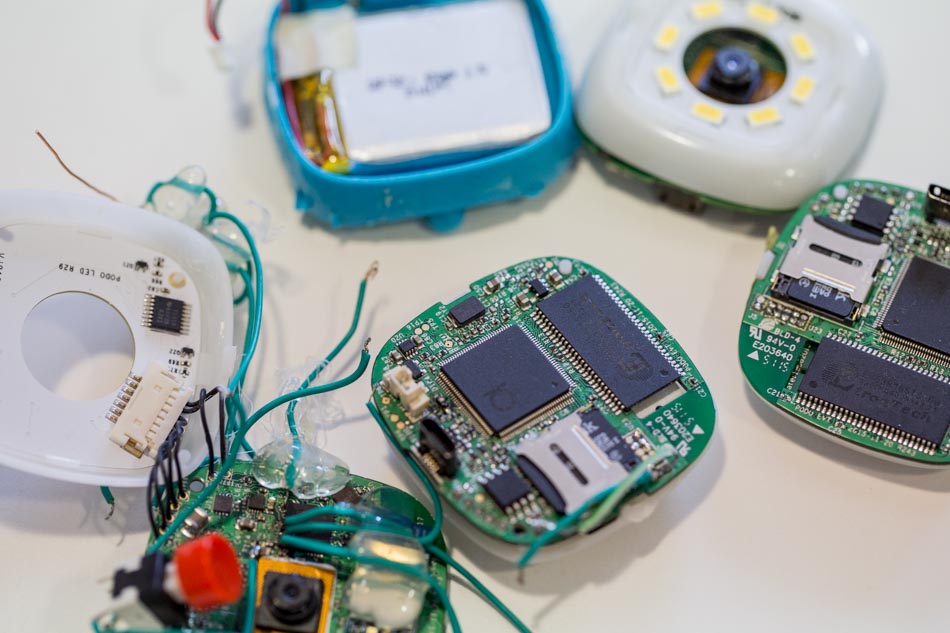
The Scylla and Charybdis of imaging technologies
Oh, if only someone could hurry up and revolutionize video, so it would take up very little space and still be HD. Until that happens, however, Podo and every other camera manufacturer is stuck with some tough decisions: Do they enable video or not? If they do, they will need to slip down that bandwidth rabbit hole. If they don’t, they risk the wrath of consumers everywhere.
Podo chose to enable. And to transfer both images and video, they use Bluetooth rather than WiFi.
“We chose Bluetooth over WiFi because of the user convenience factor,” explains Eddie. “I do wish the transfer speed for the photos were faster—it’s a lot slower than WiFi. When you take a photo, it takes anywhere from five to ten seconds to transfer, depending on your megapixel setting. But the nice thing is, you can see a live preview of the image.”
But, he adds, “videos are limited to fifteen seconds, and we have to sync the sound through the phone.”
Wait, what?
You heard right: the Podo does not record sound. Until the multi-tasking smartphone, photographic cameras have always been just image capturing devices, not sound recorders. And this is where Eddie admits they might be trying to bite off more than they can chew.
Podo has two modes, he explains. There’s the fifteen-second mode, which records image with the camera and the sound through your smartphone, and then automatically syncs and transfers the final video footage to your phone. And there’s the unlimited mode, where audio and video are also recorded separately, but the video is not sent to your smartphone. The video sits on the Podo, and you have to download it to your computer via a USB cable.
Eddie pauses for a bit. “I wonder if we never offered it, it would be a stronger value proposition.”
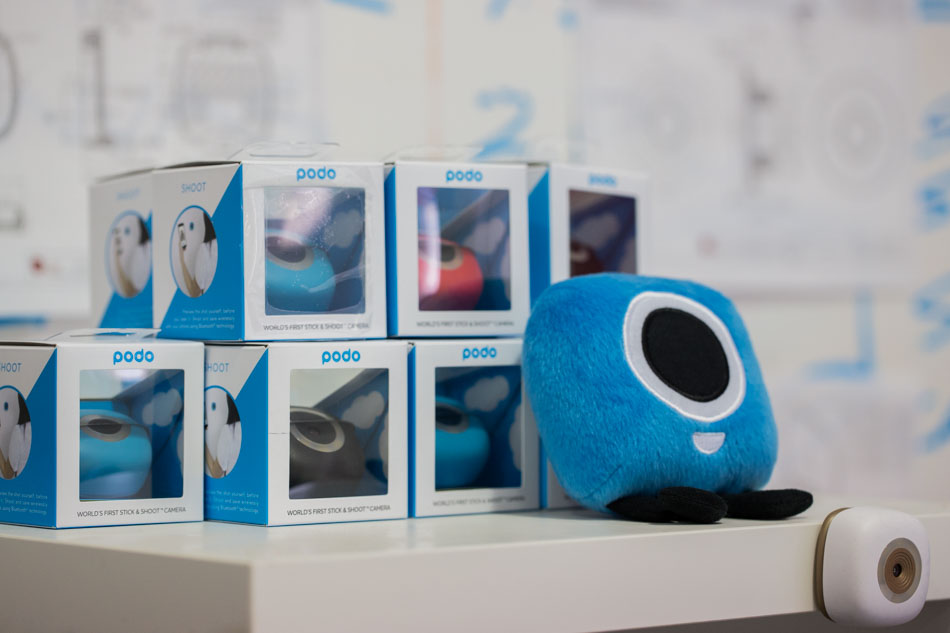
Thriving in a crowded market
Marketing, of course, is another hurdle the team must clear, and clear well in the camera space, if the Podo is going to, well, stick. They’re going in with their eyes open, however: They know they’re dealing with a crowded market.
Ironically, what startups like Podo have going for them is a crowded market—because it’s a market that’s used to new devices, gadgets, and all manner of disruptive objects popping up everywhere, all the time. In other words, it’s no shocker to anyone that a new startup has come up with yet another take on the camera. Eddie and his team no doubt hope that this will translate into a curiosity healthy enough to carry them past the point of bootstrapping and onto the path of a healthy, viable new camera company.
—
Update 9/30/16: Check out Podo’s Kickstarter campaign here!
